University Name: CHTM33 Innovation in Tourism and Hospitality Report
VerifiedAdded on 2023/04/07
|18
|3822
|468
Report
AI Summary
This report delves into the critical aspects of innovation within the tourism and hospitality sectors, particularly within the UK context. It identifies the primary challenges hindering innovation adoption, such as lack of information, educational opportunities, and digital understanding. The study explores the theoretical foundations of innovation, including diffusion theory and its five adoption categories (innovators, early adopters, early majority, late majority, and laggards), and examines influential factors like relative advantage and compatibility. Through situational analyses of ABTA, Travel Counsellors, and Trailfinders, the report highlights specific innovation barriers and suggests strategies for improvement, such as fostering a positive organizational culture, providing effective training, and encouraging risk-taking. The report also touches upon the challenges posed by destructive innovation, technological advancements, and market transparency, offering insights into how these factors impact business performance. The overall goal is to provide actionable recommendations for enhancing innovation awareness and driving growth in the tourism industry.
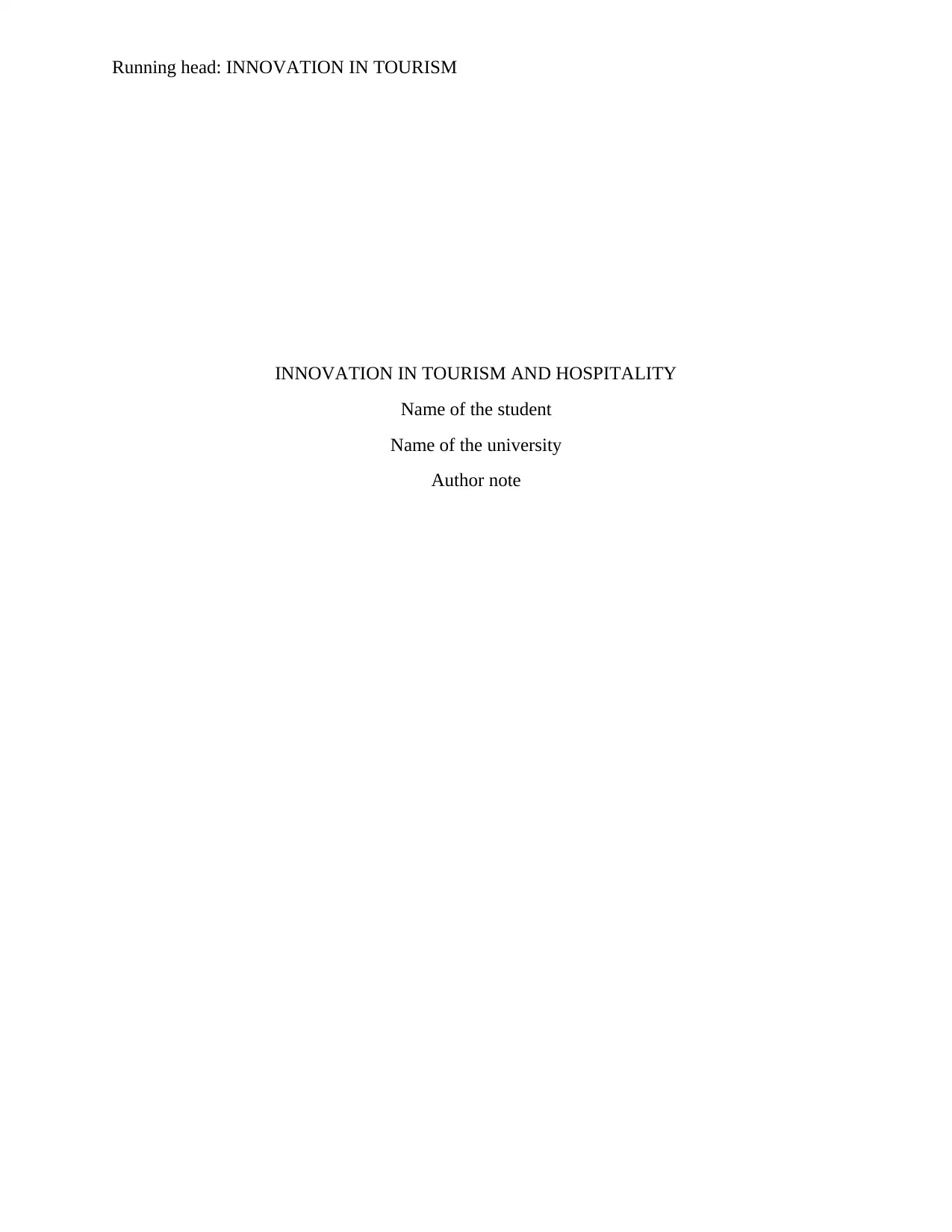
Running head: INNOVATION IN TOURISM
INNOVATION IN TOURISM AND HOSPITALITY
Name of the student
Name of the university
Author note
INNOVATION IN TOURISM AND HOSPITALITY
Name of the student
Name of the university
Author note
Paraphrase This Document
Need a fresh take? Get an instant paraphrase of this document with our AI Paraphraser
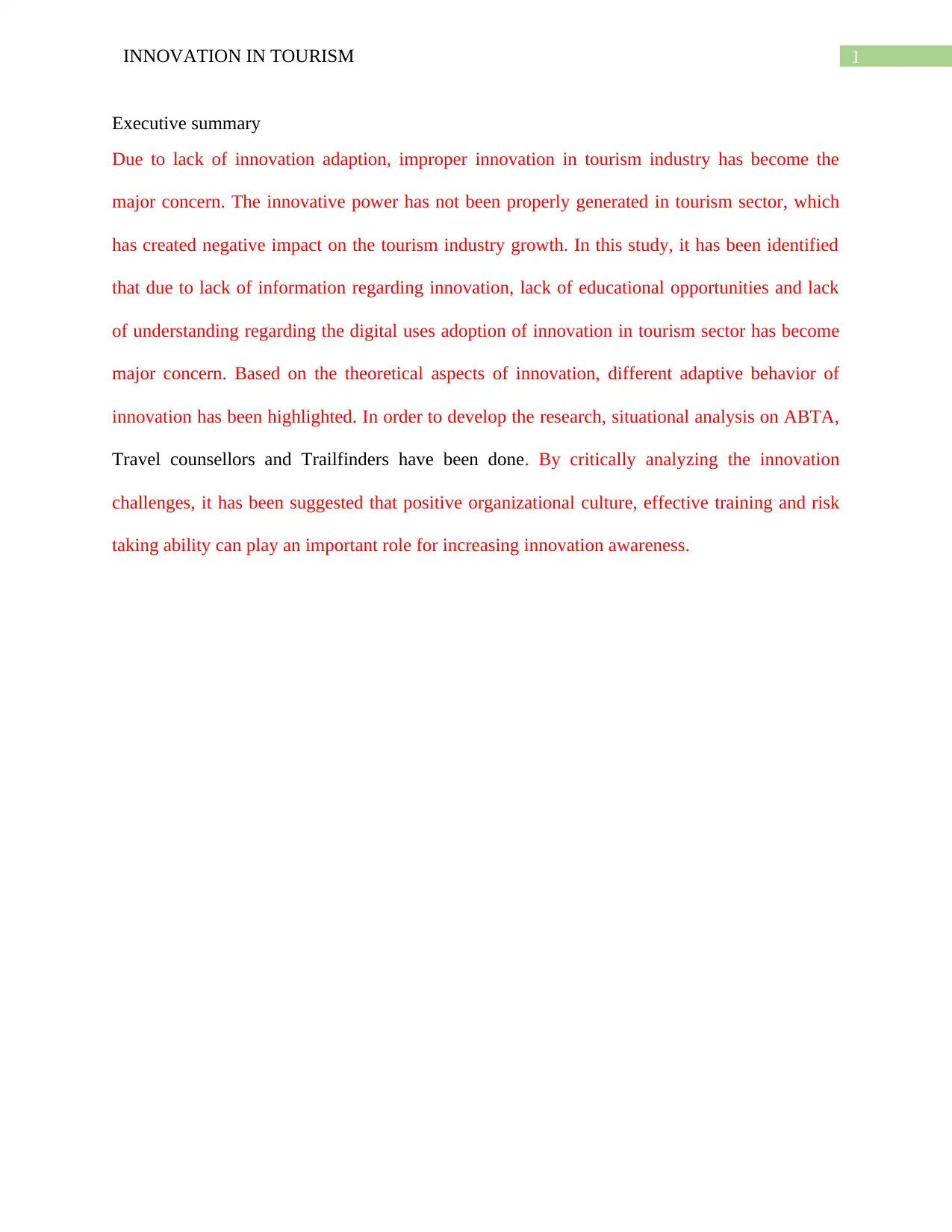
1INNOVATION IN TOURISM
Executive summary
Due to lack of innovation adaption, improper innovation in tourism industry has become the
major concern. The innovative power has not been properly generated in tourism sector, which
has created negative impact on the tourism industry growth. In this study, it has been identified
that due to lack of information regarding innovation, lack of educational opportunities and lack
of understanding regarding the digital uses adoption of innovation in tourism sector has become
major concern. Based on the theoretical aspects of innovation, different adaptive behavior of
innovation has been highlighted. In order to develop the research, situational analysis on ABTA,
Travel counsellors and Trailfinders have been done. By critically analyzing the innovation
challenges, it has been suggested that positive organizational culture, effective training and risk
taking ability can play an important role for increasing innovation awareness.
Executive summary
Due to lack of innovation adaption, improper innovation in tourism industry has become the
major concern. The innovative power has not been properly generated in tourism sector, which
has created negative impact on the tourism industry growth. In this study, it has been identified
that due to lack of information regarding innovation, lack of educational opportunities and lack
of understanding regarding the digital uses adoption of innovation in tourism sector has become
major concern. Based on the theoretical aspects of innovation, different adaptive behavior of
innovation has been highlighted. In order to develop the research, situational analysis on ABTA,
Travel counsellors and Trailfinders have been done. By critically analyzing the innovation
challenges, it has been suggested that positive organizational culture, effective training and risk
taking ability can play an important role for increasing innovation awareness.
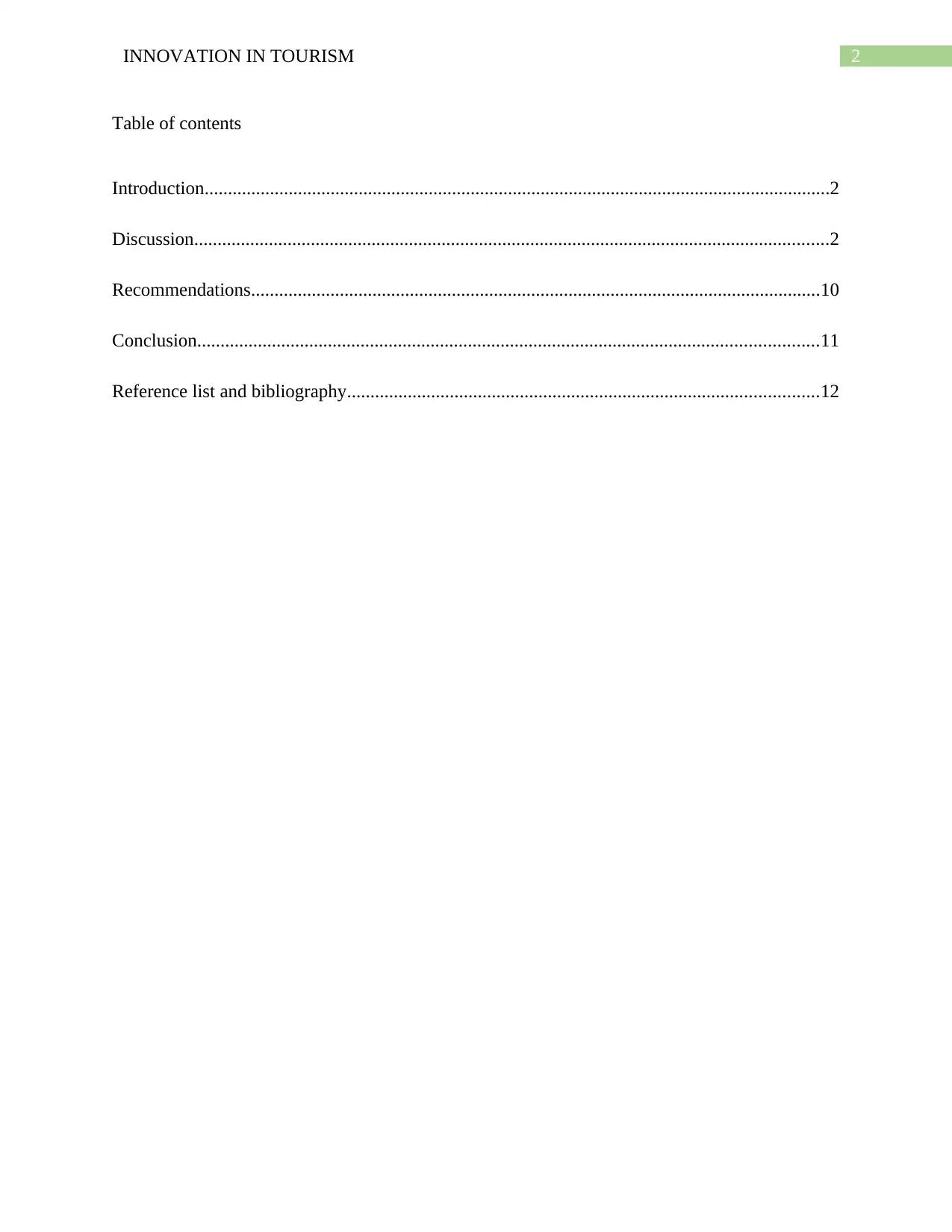
2INNOVATION IN TOURISM
Table of contents
Introduction......................................................................................................................................2
Discussion........................................................................................................................................2
Recommendations..........................................................................................................................10
Conclusion.....................................................................................................................................11
Reference list and bibliography.....................................................................................................12
Table of contents
Introduction......................................................................................................................................2
Discussion........................................................................................................................................2
Recommendations..........................................................................................................................10
Conclusion.....................................................................................................................................11
Reference list and bibliography.....................................................................................................12
⊘ This is a preview!⊘
Do you want full access?
Subscribe today to unlock all pages.

Trusted by 1+ million students worldwide
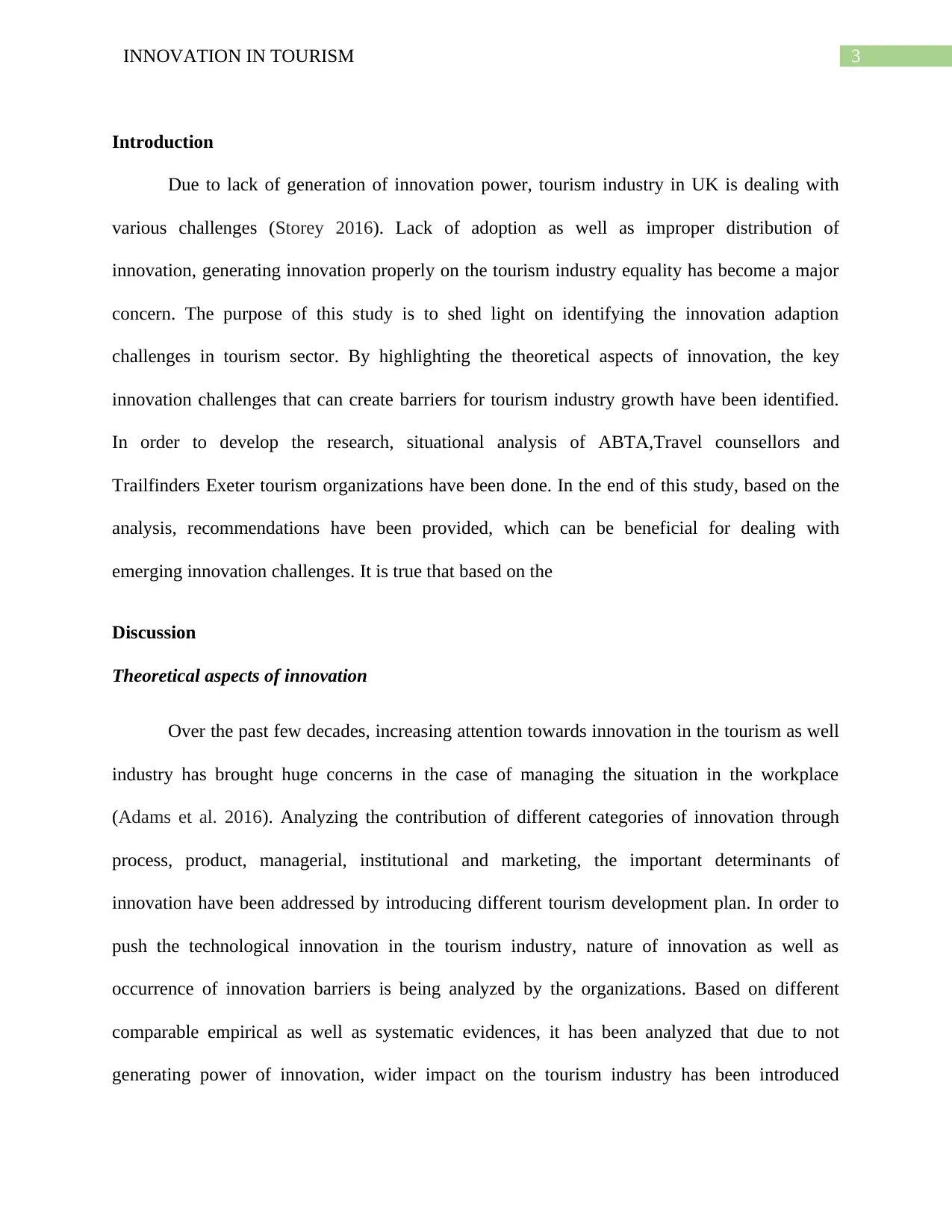
3INNOVATION IN TOURISM
Introduction
Due to lack of generation of innovation power, tourism industry in UK is dealing with
various challenges (Storey 2016). Lack of adoption as well as improper distribution of
innovation, generating innovation properly on the tourism industry equality has become a major
concern. The purpose of this study is to shed light on identifying the innovation adaption
challenges in tourism sector. By highlighting the theoretical aspects of innovation, the key
innovation challenges that can create barriers for tourism industry growth have been identified.
In order to develop the research, situational analysis of ABTA,Travel counsellors and
Trailfinders Exeter tourism organizations have been done. In the end of this study, based on the
analysis, recommendations have been provided, which can be beneficial for dealing with
emerging innovation challenges. It is true that based on the
Discussion
Theoretical aspects of innovation
Over the past few decades, increasing attention towards innovation in the tourism as well
industry has brought huge concerns in the case of managing the situation in the workplace
(Adams et al. 2016). Analyzing the contribution of different categories of innovation through
process, product, managerial, institutional and marketing, the important determinants of
innovation have been addressed by introducing different tourism development plan. In order to
push the technological innovation in the tourism industry, nature of innovation as well as
occurrence of innovation barriers is being analyzed by the organizations. Based on different
comparable empirical as well as systematic evidences, it has been analyzed that due to not
generating power of innovation, wider impact on the tourism industry has been introduced
Introduction
Due to lack of generation of innovation power, tourism industry in UK is dealing with
various challenges (Storey 2016). Lack of adoption as well as improper distribution of
innovation, generating innovation properly on the tourism industry equality has become a major
concern. The purpose of this study is to shed light on identifying the innovation adaption
challenges in tourism sector. By highlighting the theoretical aspects of innovation, the key
innovation challenges that can create barriers for tourism industry growth have been identified.
In order to develop the research, situational analysis of ABTA,Travel counsellors and
Trailfinders Exeter tourism organizations have been done. In the end of this study, based on the
analysis, recommendations have been provided, which can be beneficial for dealing with
emerging innovation challenges. It is true that based on the
Discussion
Theoretical aspects of innovation
Over the past few decades, increasing attention towards innovation in the tourism as well
industry has brought huge concerns in the case of managing the situation in the workplace
(Adams et al. 2016). Analyzing the contribution of different categories of innovation through
process, product, managerial, institutional and marketing, the important determinants of
innovation have been addressed by introducing different tourism development plan. In order to
push the technological innovation in the tourism industry, nature of innovation as well as
occurrence of innovation barriers is being analyzed by the organizations. Based on different
comparable empirical as well as systematic evidences, it has been analyzed that due to not
generating power of innovation, wider impact on the tourism industry has been introduced
Paraphrase This Document
Need a fresh take? Get an instant paraphrase of this document with our AI Paraphraser
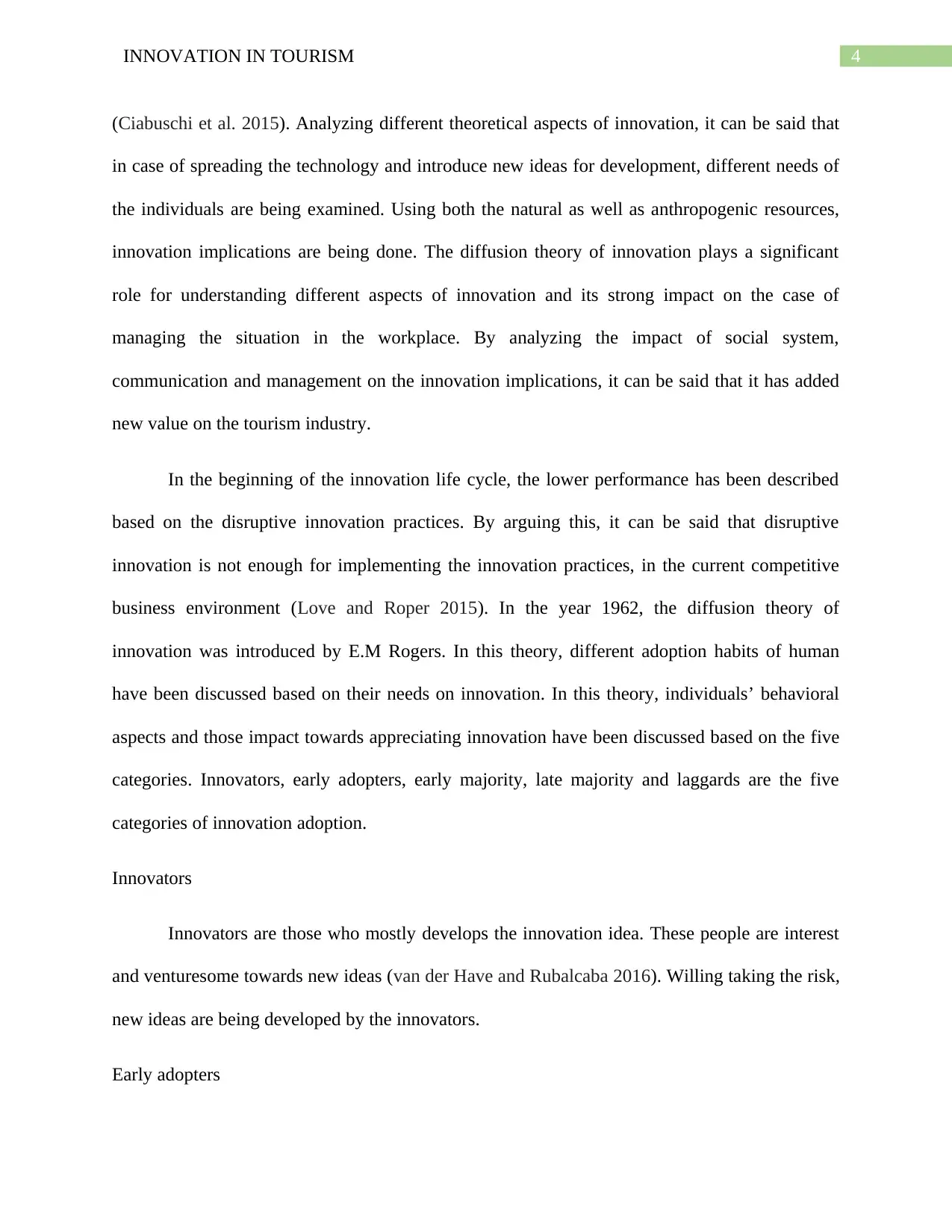
4INNOVATION IN TOURISM
(Ciabuschi et al. 2015). Analyzing different theoretical aspects of innovation, it can be said that
in case of spreading the technology and introduce new ideas for development, different needs of
the individuals are being examined. Using both the natural as well as anthropogenic resources,
innovation implications are being done. The diffusion theory of innovation plays a significant
role for understanding different aspects of innovation and its strong impact on the case of
managing the situation in the workplace. By analyzing the impact of social system,
communication and management on the innovation implications, it can be said that it has added
new value on the tourism industry.
In the beginning of the innovation life cycle, the lower performance has been described
based on the disruptive innovation practices. By arguing this, it can be said that disruptive
innovation is not enough for implementing the innovation practices, in the current competitive
business environment (Love and Roper 2015). In the year 1962, the diffusion theory of
innovation was introduced by E.M Rogers. In this theory, different adoption habits of human
have been discussed based on their needs on innovation. In this theory, individuals’ behavioral
aspects and those impact towards appreciating innovation have been discussed based on the five
categories. Innovators, early adopters, early majority, late majority and laggards are the five
categories of innovation adoption.
Innovators
Innovators are those who mostly develops the innovation idea. These people are interest
and venturesome towards new ideas (van der Have and Rubalcaba 2016). Willing taking the risk,
new ideas are being developed by the innovators.
Early adopters
(Ciabuschi et al. 2015). Analyzing different theoretical aspects of innovation, it can be said that
in case of spreading the technology and introduce new ideas for development, different needs of
the individuals are being examined. Using both the natural as well as anthropogenic resources,
innovation implications are being done. The diffusion theory of innovation plays a significant
role for understanding different aspects of innovation and its strong impact on the case of
managing the situation in the workplace. By analyzing the impact of social system,
communication and management on the innovation implications, it can be said that it has added
new value on the tourism industry.
In the beginning of the innovation life cycle, the lower performance has been described
based on the disruptive innovation practices. By arguing this, it can be said that disruptive
innovation is not enough for implementing the innovation practices, in the current competitive
business environment (Love and Roper 2015). In the year 1962, the diffusion theory of
innovation was introduced by E.M Rogers. In this theory, different adoption habits of human
have been discussed based on their needs on innovation. In this theory, individuals’ behavioral
aspects and those impact towards appreciating innovation have been discussed based on the five
categories. Innovators, early adopters, early majority, late majority and laggards are the five
categories of innovation adoption.
Innovators
Innovators are those who mostly develops the innovation idea. These people are interest
and venturesome towards new ideas (van der Have and Rubalcaba 2016). Willing taking the risk,
new ideas are being developed by the innovators.
Early adopters
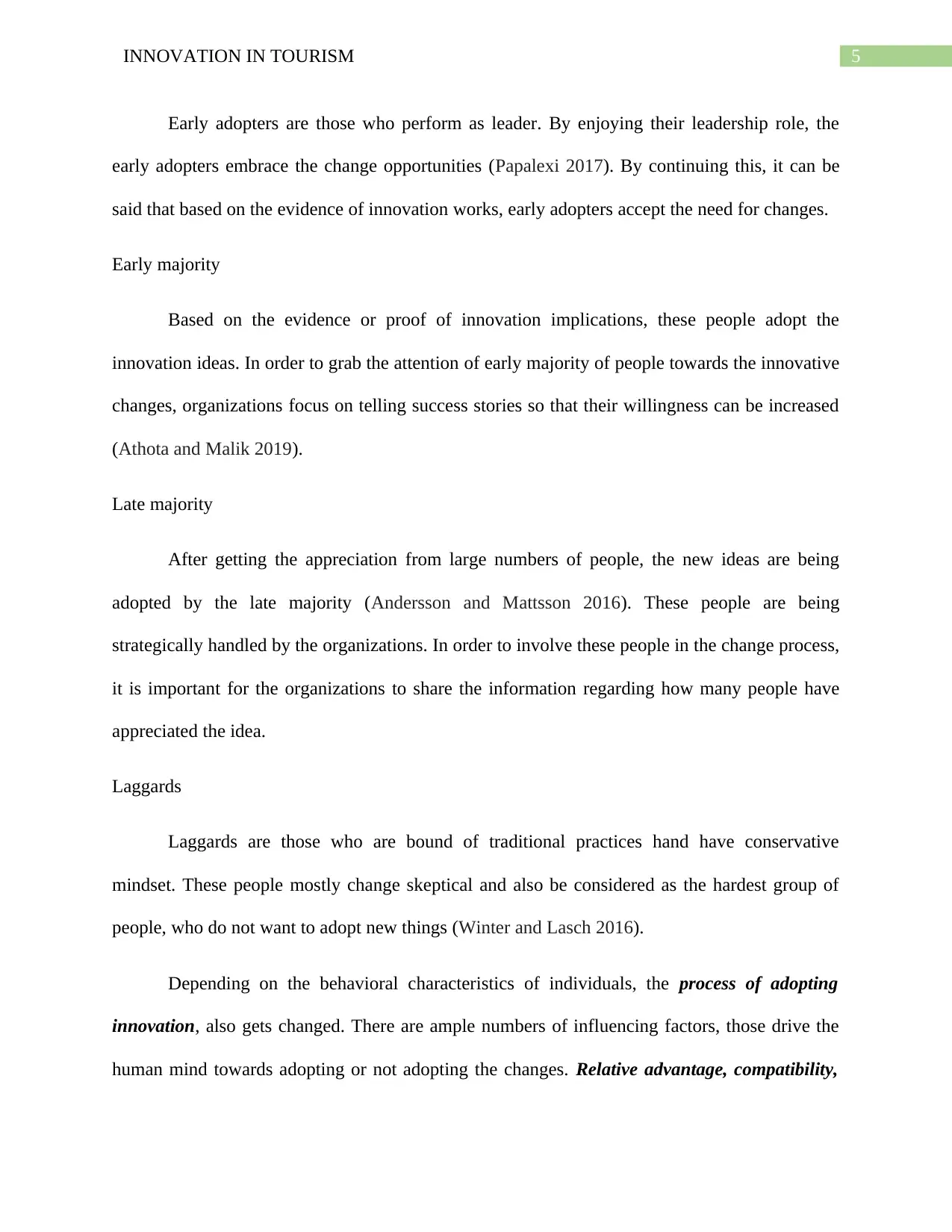
5INNOVATION IN TOURISM
Early adopters are those who perform as leader. By enjoying their leadership role, the
early adopters embrace the change opportunities (Papalexi 2017). By continuing this, it can be
said that based on the evidence of innovation works, early adopters accept the need for changes.
Early majority
Based on the evidence or proof of innovation implications, these people adopt the
innovation ideas. In order to grab the attention of early majority of people towards the innovative
changes, organizations focus on telling success stories so that their willingness can be increased
(Athota and Malik 2019).
Late majority
After getting the appreciation from large numbers of people, the new ideas are being
adopted by the late majority (Andersson and Mattsson 2016). These people are being
strategically handled by the organizations. In order to involve these people in the change process,
it is important for the organizations to share the information regarding how many people have
appreciated the idea.
Laggards
Laggards are those who are bound of traditional practices hand have conservative
mindset. These people mostly change skeptical and also be considered as the hardest group of
people, who do not want to adopt new things (Winter and Lasch 2016).
Depending on the behavioral characteristics of individuals, the process of adopting
innovation, also gets changed. There are ample numbers of influencing factors, those drive the
human mind towards adopting or not adopting the changes. Relative advantage, compatibility,
Early adopters are those who perform as leader. By enjoying their leadership role, the
early adopters embrace the change opportunities (Papalexi 2017). By continuing this, it can be
said that based on the evidence of innovation works, early adopters accept the need for changes.
Early majority
Based on the evidence or proof of innovation implications, these people adopt the
innovation ideas. In order to grab the attention of early majority of people towards the innovative
changes, organizations focus on telling success stories so that their willingness can be increased
(Athota and Malik 2019).
Late majority
After getting the appreciation from large numbers of people, the new ideas are being
adopted by the late majority (Andersson and Mattsson 2016). These people are being
strategically handled by the organizations. In order to involve these people in the change process,
it is important for the organizations to share the information regarding how many people have
appreciated the idea.
Laggards
Laggards are those who are bound of traditional practices hand have conservative
mindset. These people mostly change skeptical and also be considered as the hardest group of
people, who do not want to adopt new things (Winter and Lasch 2016).
Depending on the behavioral characteristics of individuals, the process of adopting
innovation, also gets changed. There are ample numbers of influencing factors, those drive the
human mind towards adopting or not adopting the changes. Relative advantage, compatibility,
⊘ This is a preview!⊘
Do you want full access?
Subscribe today to unlock all pages.

Trusted by 1+ million students worldwide
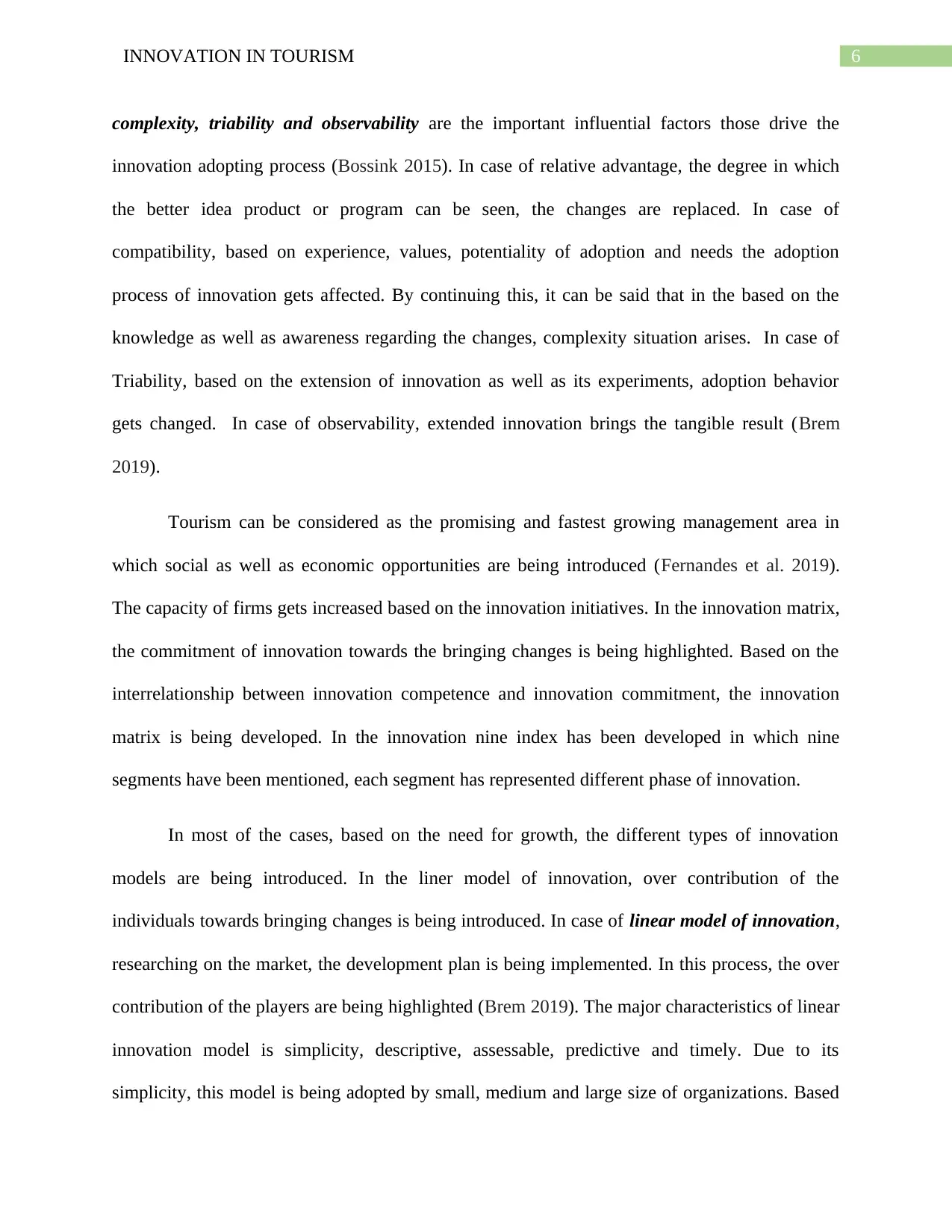
6INNOVATION IN TOURISM
complexity, triability and observability are the important influential factors those drive the
innovation adopting process (Bossink 2015). In case of relative advantage, the degree in which
the better idea product or program can be seen, the changes are replaced. In case of
compatibility, based on experience, values, potentiality of adoption and needs the adoption
process of innovation gets affected. By continuing this, it can be said that in the based on the
knowledge as well as awareness regarding the changes, complexity situation arises. In case of
Triability, based on the extension of innovation as well as its experiments, adoption behavior
gets changed. In case of observability, extended innovation brings the tangible result (Brem
2019).
Tourism can be considered as the promising and fastest growing management area in
which social as well as economic opportunities are being introduced (Fernandes et al. 2019).
The capacity of firms gets increased based on the innovation initiatives. In the innovation matrix,
the commitment of innovation towards the bringing changes is being highlighted. Based on the
interrelationship between innovation competence and innovation commitment, the innovation
matrix is being developed. In the innovation nine index has been developed in which nine
segments have been mentioned, each segment has represented different phase of innovation.
In most of the cases, based on the need for growth, the different types of innovation
models are being introduced. In the liner model of innovation, over contribution of the
individuals towards bringing changes is being introduced. In case of linear model of innovation,
researching on the market, the development plan is being implemented. In this process, the over
contribution of the players are being highlighted (Brem 2019). The major characteristics of linear
innovation model is simplicity, descriptive, assessable, predictive and timely. Due to its
simplicity, this model is being adopted by small, medium and large size of organizations. Based
complexity, triability and observability are the important influential factors those drive the
innovation adopting process (Bossink 2015). In case of relative advantage, the degree in which
the better idea product or program can be seen, the changes are replaced. In case of
compatibility, based on experience, values, potentiality of adoption and needs the adoption
process of innovation gets affected. By continuing this, it can be said that in the based on the
knowledge as well as awareness regarding the changes, complexity situation arises. In case of
Triability, based on the extension of innovation as well as its experiments, adoption behavior
gets changed. In case of observability, extended innovation brings the tangible result (Brem
2019).
Tourism can be considered as the promising and fastest growing management area in
which social as well as economic opportunities are being introduced (Fernandes et al. 2019).
The capacity of firms gets increased based on the innovation initiatives. In the innovation matrix,
the commitment of innovation towards the bringing changes is being highlighted. Based on the
interrelationship between innovation competence and innovation commitment, the innovation
matrix is being developed. In the innovation nine index has been developed in which nine
segments have been mentioned, each segment has represented different phase of innovation.
In most of the cases, based on the need for growth, the different types of innovation
models are being introduced. In the liner model of innovation, over contribution of the
individuals towards bringing changes is being introduced. In case of linear model of innovation,
researching on the market, the development plan is being implemented. In this process, the over
contribution of the players are being highlighted (Brem 2019). The major characteristics of linear
innovation model is simplicity, descriptive, assessable, predictive and timely. Due to its
simplicity, this model is being adopted by small, medium and large size of organizations. Based
Paraphrase This Document
Need a fresh take? Get an instant paraphrase of this document with our AI Paraphraser
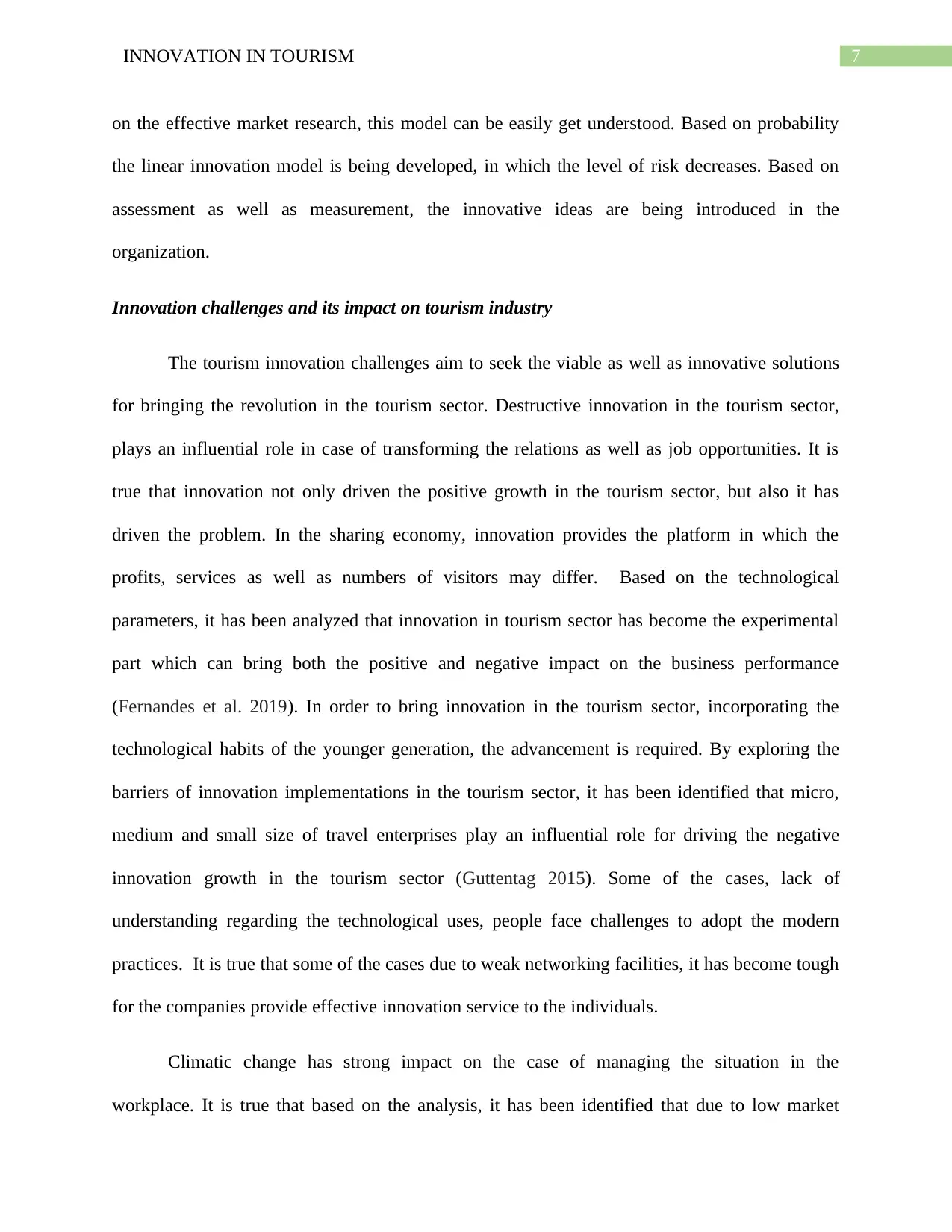
7INNOVATION IN TOURISM
on the effective market research, this model can be easily get understood. Based on probability
the linear innovation model is being developed, in which the level of risk decreases. Based on
assessment as well as measurement, the innovative ideas are being introduced in the
organization.
Innovation challenges and its impact on tourism industry
The tourism innovation challenges aim to seek the viable as well as innovative solutions
for bringing the revolution in the tourism sector. Destructive innovation in the tourism sector,
plays an influential role in case of transforming the relations as well as job opportunities. It is
true that innovation not only driven the positive growth in the tourism sector, but also it has
driven the problem. In the sharing economy, innovation provides the platform in which the
profits, services as well as numbers of visitors may differ. Based on the technological
parameters, it has been analyzed that innovation in tourism sector has become the experimental
part which can bring both the positive and negative impact on the business performance
(Fernandes et al. 2019). In order to bring innovation in the tourism sector, incorporating the
technological habits of the younger generation, the advancement is required. By exploring the
barriers of innovation implementations in the tourism sector, it has been identified that micro,
medium and small size of travel enterprises play an influential role for driving the negative
innovation growth in the tourism sector (Guttentag 2015). Some of the cases, lack of
understanding regarding the technological uses, people face challenges to adopt the modern
practices. It is true that some of the cases due to weak networking facilities, it has become tough
for the companies provide effective innovation service to the individuals.
Climatic change has strong impact on the case of managing the situation in the
workplace. It is true that based on the analysis, it has been identified that due to low market
on the effective market research, this model can be easily get understood. Based on probability
the linear innovation model is being developed, in which the level of risk decreases. Based on
assessment as well as measurement, the innovative ideas are being introduced in the
organization.
Innovation challenges and its impact on tourism industry
The tourism innovation challenges aim to seek the viable as well as innovative solutions
for bringing the revolution in the tourism sector. Destructive innovation in the tourism sector,
plays an influential role in case of transforming the relations as well as job opportunities. It is
true that innovation not only driven the positive growth in the tourism sector, but also it has
driven the problem. In the sharing economy, innovation provides the platform in which the
profits, services as well as numbers of visitors may differ. Based on the technological
parameters, it has been analyzed that innovation in tourism sector has become the experimental
part which can bring both the positive and negative impact on the business performance
(Fernandes et al. 2019). In order to bring innovation in the tourism sector, incorporating the
technological habits of the younger generation, the advancement is required. By exploring the
barriers of innovation implementations in the tourism sector, it has been identified that micro,
medium and small size of travel enterprises play an influential role for driving the negative
innovation growth in the tourism sector (Guttentag 2015). Some of the cases, lack of
understanding regarding the technological uses, people face challenges to adopt the modern
practices. It is true that some of the cases due to weak networking facilities, it has become tough
for the companies provide effective innovation service to the individuals.
Climatic change has strong impact on the case of managing the situation in the
workplace. It is true that based on the analysis, it has been identified that due to low market
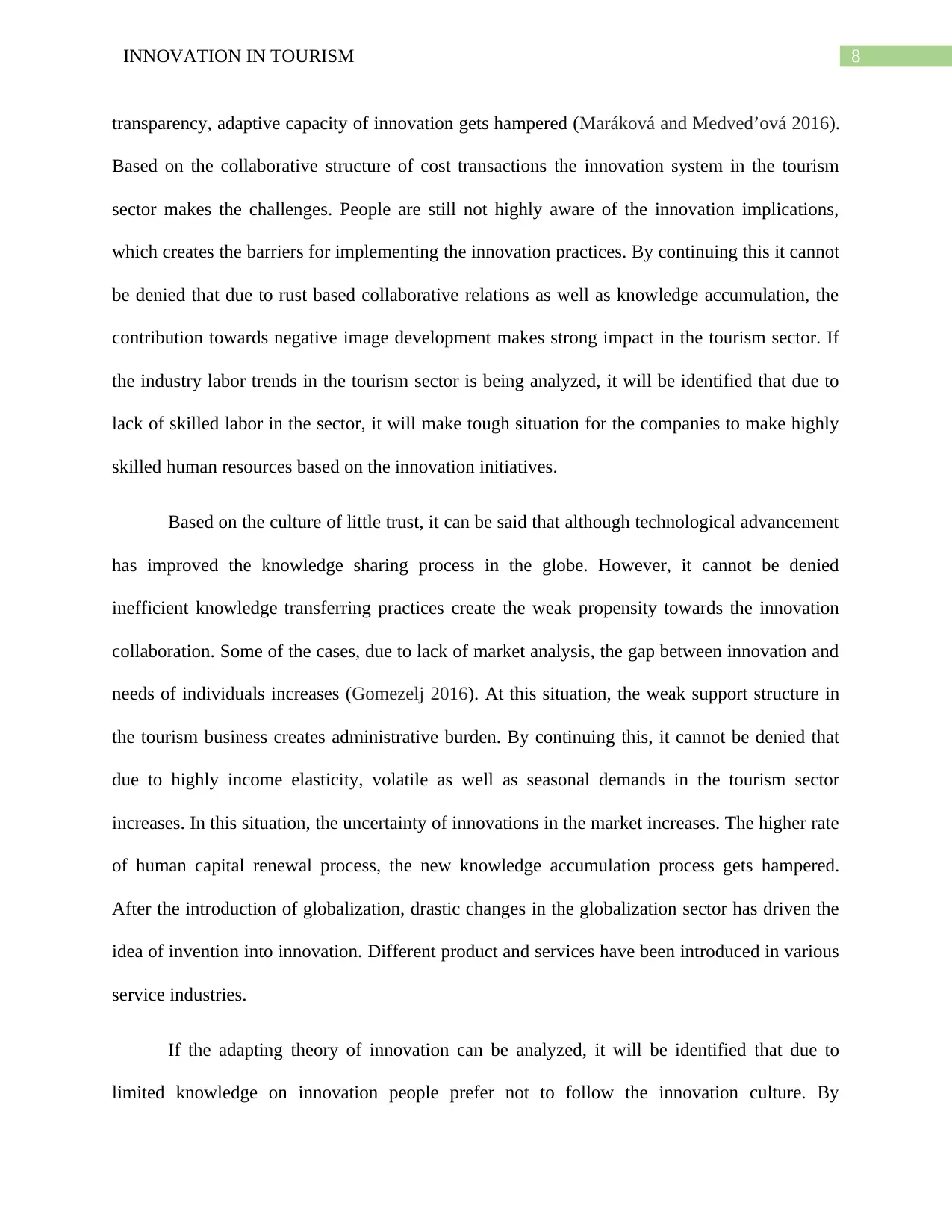
8INNOVATION IN TOURISM
transparency, adaptive capacity of innovation gets hampered (Maráková and Medved’ová 2016).
Based on the collaborative structure of cost transactions the innovation system in the tourism
sector makes the challenges. People are still not highly aware of the innovation implications,
which creates the barriers for implementing the innovation practices. By continuing this it cannot
be denied that due to rust based collaborative relations as well as knowledge accumulation, the
contribution towards negative image development makes strong impact in the tourism sector. If
the industry labor trends in the tourism sector is being analyzed, it will be identified that due to
lack of skilled labor in the sector, it will make tough situation for the companies to make highly
skilled human resources based on the innovation initiatives.
Based on the culture of little trust, it can be said that although technological advancement
has improved the knowledge sharing process in the globe. However, it cannot be denied
inefficient knowledge transferring practices create the weak propensity towards the innovation
collaboration. Some of the cases, due to lack of market analysis, the gap between innovation and
needs of individuals increases (Gomezelj 2016). At this situation, the weak support structure in
the tourism business creates administrative burden. By continuing this, it cannot be denied that
due to highly income elasticity, volatile as well as seasonal demands in the tourism sector
increases. In this situation, the uncertainty of innovations in the market increases. The higher rate
of human capital renewal process, the new knowledge accumulation process gets hampered.
After the introduction of globalization, drastic changes in the globalization sector has driven the
idea of invention into innovation. Different product and services have been introduced in various
service industries.
If the adapting theory of innovation can be analyzed, it will be identified that due to
limited knowledge on innovation people prefer not to follow the innovation culture. By
transparency, adaptive capacity of innovation gets hampered (Maráková and Medved’ová 2016).
Based on the collaborative structure of cost transactions the innovation system in the tourism
sector makes the challenges. People are still not highly aware of the innovation implications,
which creates the barriers for implementing the innovation practices. By continuing this it cannot
be denied that due to rust based collaborative relations as well as knowledge accumulation, the
contribution towards negative image development makes strong impact in the tourism sector. If
the industry labor trends in the tourism sector is being analyzed, it will be identified that due to
lack of skilled labor in the sector, it will make tough situation for the companies to make highly
skilled human resources based on the innovation initiatives.
Based on the culture of little trust, it can be said that although technological advancement
has improved the knowledge sharing process in the globe. However, it cannot be denied
inefficient knowledge transferring practices create the weak propensity towards the innovation
collaboration. Some of the cases, due to lack of market analysis, the gap between innovation and
needs of individuals increases (Gomezelj 2016). At this situation, the weak support structure in
the tourism business creates administrative burden. By continuing this, it cannot be denied that
due to highly income elasticity, volatile as well as seasonal demands in the tourism sector
increases. In this situation, the uncertainty of innovations in the market increases. The higher rate
of human capital renewal process, the new knowledge accumulation process gets hampered.
After the introduction of globalization, drastic changes in the globalization sector has driven the
idea of invention into innovation. Different product and services have been introduced in various
service industries.
If the adapting theory of innovation can be analyzed, it will be identified that due to
limited knowledge on innovation people prefer not to follow the innovation culture. By
⊘ This is a preview!⊘
Do you want full access?
Subscribe today to unlock all pages.

Trusted by 1+ million students worldwide
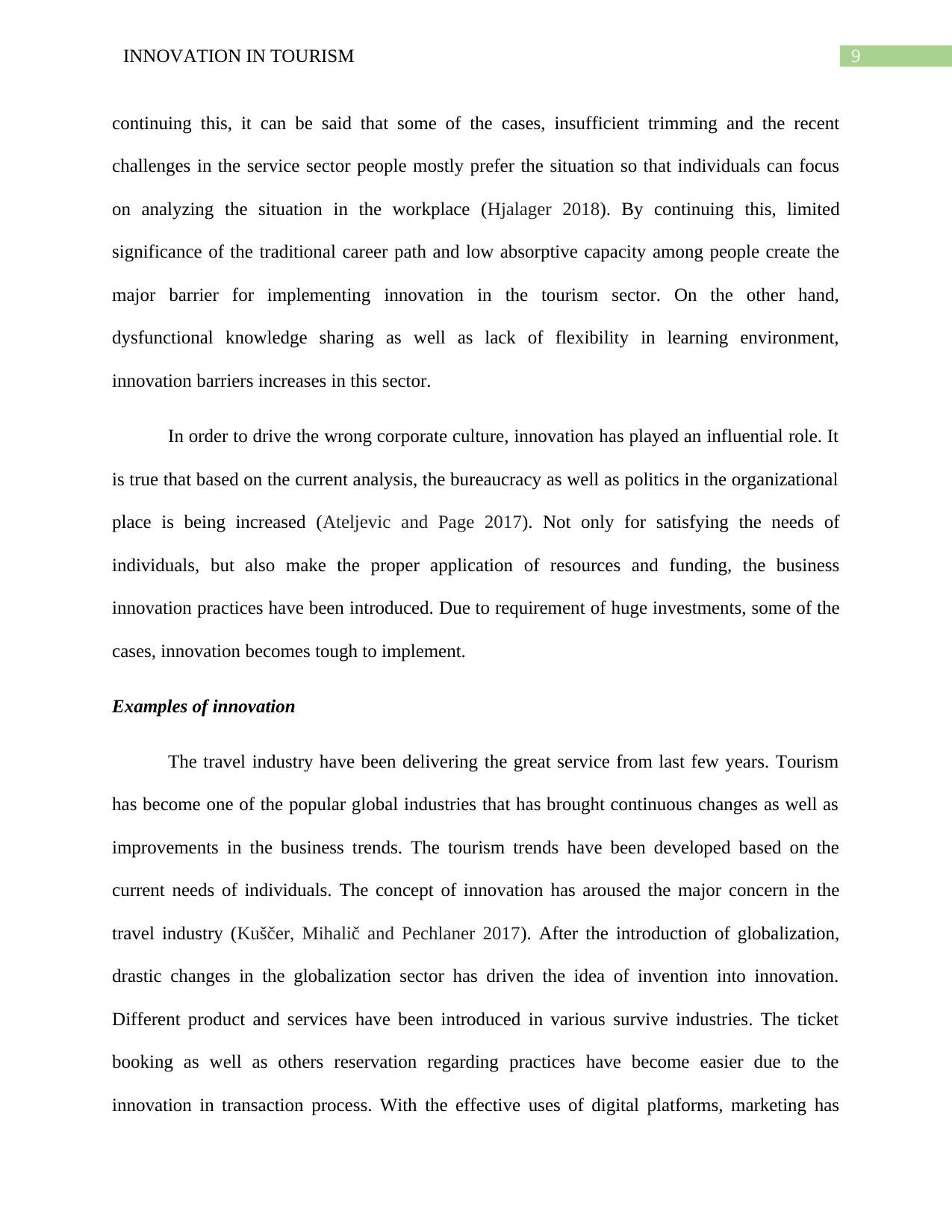
9INNOVATION IN TOURISM
continuing this, it can be said that some of the cases, insufficient trimming and the recent
challenges in the service sector people mostly prefer the situation so that individuals can focus
on analyzing the situation in the workplace (Hjalager 2018). By continuing this, limited
significance of the traditional career path and low absorptive capacity among people create the
major barrier for implementing innovation in the tourism sector. On the other hand,
dysfunctional knowledge sharing as well as lack of flexibility in learning environment,
innovation barriers increases in this sector.
In order to drive the wrong corporate culture, innovation has played an influential role. It
is true that based on the current analysis, the bureaucracy as well as politics in the organizational
place is being increased (Ateljevic and Page 2017). Not only for satisfying the needs of
individuals, but also make the proper application of resources and funding, the business
innovation practices have been introduced. Due to requirement of huge investments, some of the
cases, innovation becomes tough to implement.
Examples of innovation
The travel industry have been delivering the great service from last few years. Tourism
has become one of the popular global industries that has brought continuous changes as well as
improvements in the business trends. The tourism trends have been developed based on the
current needs of individuals. The concept of innovation has aroused the major concern in the
travel industry (Kuščer, Mihalič and Pechlaner 2017). After the introduction of globalization,
drastic changes in the globalization sector has driven the idea of invention into innovation.
Different product and services have been introduced in various survive industries. The ticket
booking as well as others reservation regarding practices have become easier due to the
innovation in transaction process. With the effective uses of digital platforms, marketing has
continuing this, it can be said that some of the cases, insufficient trimming and the recent
challenges in the service sector people mostly prefer the situation so that individuals can focus
on analyzing the situation in the workplace (Hjalager 2018). By continuing this, limited
significance of the traditional career path and low absorptive capacity among people create the
major barrier for implementing innovation in the tourism sector. On the other hand,
dysfunctional knowledge sharing as well as lack of flexibility in learning environment,
innovation barriers increases in this sector.
In order to drive the wrong corporate culture, innovation has played an influential role. It
is true that based on the current analysis, the bureaucracy as well as politics in the organizational
place is being increased (Ateljevic and Page 2017). Not only for satisfying the needs of
individuals, but also make the proper application of resources and funding, the business
innovation practices have been introduced. Due to requirement of huge investments, some of the
cases, innovation becomes tough to implement.
Examples of innovation
The travel industry have been delivering the great service from last few years. Tourism
has become one of the popular global industries that has brought continuous changes as well as
improvements in the business trends. The tourism trends have been developed based on the
current needs of individuals. The concept of innovation has aroused the major concern in the
travel industry (Kuščer, Mihalič and Pechlaner 2017). After the introduction of globalization,
drastic changes in the globalization sector has driven the idea of invention into innovation.
Different product and services have been introduced in various survive industries. The ticket
booking as well as others reservation regarding practices have become easier due to the
innovation in transaction process. With the effective uses of digital platforms, marketing has
Paraphrase This Document
Need a fresh take? Get an instant paraphrase of this document with our AI Paraphraser
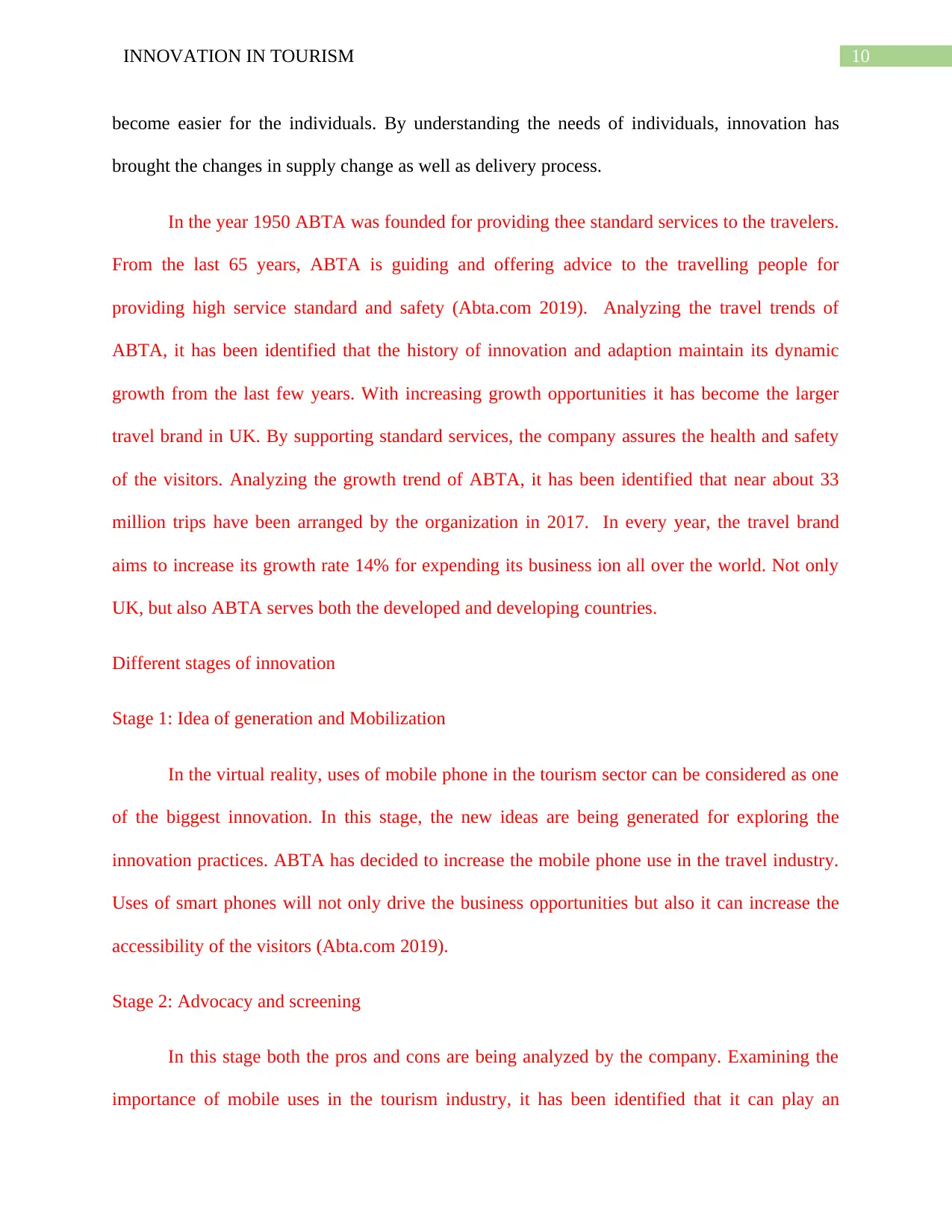
10INNOVATION IN TOURISM
become easier for the individuals. By understanding the needs of individuals, innovation has
brought the changes in supply change as well as delivery process.
In the year 1950 ABTA was founded for providing thee standard services to the travelers.
From the last 65 years, ABTA is guiding and offering advice to the travelling people for
providing high service standard and safety (Abta.com 2019). Analyzing the travel trends of
ABTA, it has been identified that the history of innovation and adaption maintain its dynamic
growth from the last few years. With increasing growth opportunities it has become the larger
travel brand in UK. By supporting standard services, the company assures the health and safety
of the visitors. Analyzing the growth trend of ABTA, it has been identified that near about 33
million trips have been arranged by the organization in 2017. In every year, the travel brand
aims to increase its growth rate 14% for expending its business ion all over the world. Not only
UK, but also ABTA serves both the developed and developing countries.
Different stages of innovation
Stage 1: Idea of generation and Mobilization
In the virtual reality, uses of mobile phone in the tourism sector can be considered as one
of the biggest innovation. In this stage, the new ideas are being generated for exploring the
innovation practices. ABTA has decided to increase the mobile phone use in the travel industry.
Uses of smart phones will not only drive the business opportunities but also it can increase the
accessibility of the visitors (Abta.com 2019).
Stage 2: Advocacy and screening
In this stage both the pros and cons are being analyzed by the company. Examining the
importance of mobile uses in the tourism industry, it has been identified that it can play an
become easier for the individuals. By understanding the needs of individuals, innovation has
brought the changes in supply change as well as delivery process.
In the year 1950 ABTA was founded for providing thee standard services to the travelers.
From the last 65 years, ABTA is guiding and offering advice to the travelling people for
providing high service standard and safety (Abta.com 2019). Analyzing the travel trends of
ABTA, it has been identified that the history of innovation and adaption maintain its dynamic
growth from the last few years. With increasing growth opportunities it has become the larger
travel brand in UK. By supporting standard services, the company assures the health and safety
of the visitors. Analyzing the growth trend of ABTA, it has been identified that near about 33
million trips have been arranged by the organization in 2017. In every year, the travel brand
aims to increase its growth rate 14% for expending its business ion all over the world. Not only
UK, but also ABTA serves both the developed and developing countries.
Different stages of innovation
Stage 1: Idea of generation and Mobilization
In the virtual reality, uses of mobile phone in the tourism sector can be considered as one
of the biggest innovation. In this stage, the new ideas are being generated for exploring the
innovation practices. ABTA has decided to increase the mobile phone use in the travel industry.
Uses of smart phones will not only drive the business opportunities but also it can increase the
accessibility of the visitors (Abta.com 2019).
Stage 2: Advocacy and screening
In this stage both the pros and cons are being analyzed by the company. Examining the
importance of mobile uses in the tourism industry, it has been identified that it can play an
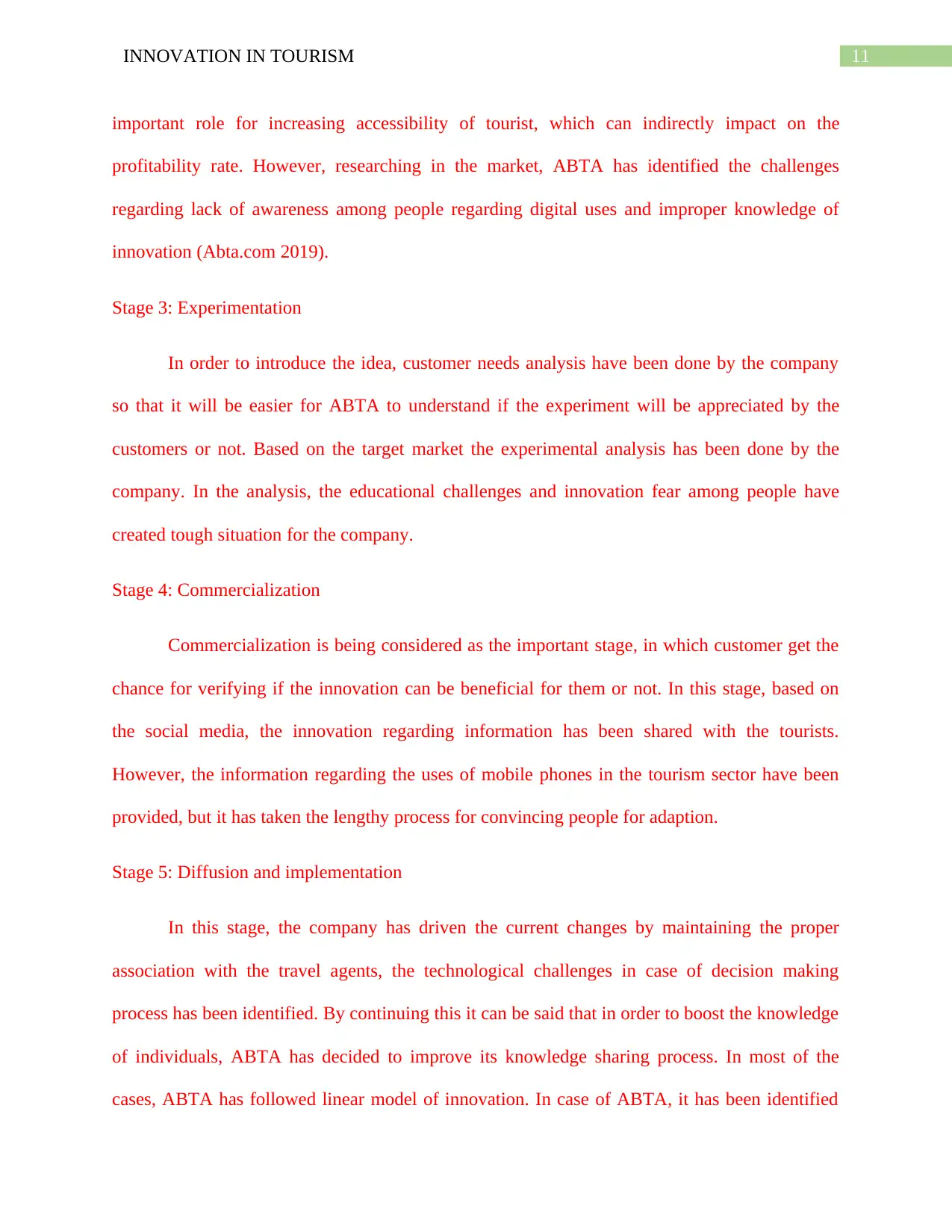
11INNOVATION IN TOURISM
important role for increasing accessibility of tourist, which can indirectly impact on the
profitability rate. However, researching in the market, ABTA has identified the challenges
regarding lack of awareness among people regarding digital uses and improper knowledge of
innovation (Abta.com 2019).
Stage 3: Experimentation
In order to introduce the idea, customer needs analysis have been done by the company
so that it will be easier for ABTA to understand if the experiment will be appreciated by the
customers or not. Based on the target market the experimental analysis has been done by the
company. In the analysis, the educational challenges and innovation fear among people have
created tough situation for the company.
Stage 4: Commercialization
Commercialization is being considered as the important stage, in which customer get the
chance for verifying if the innovation can be beneficial for them or not. In this stage, based on
the social media, the innovation regarding information has been shared with the tourists.
However, the information regarding the uses of mobile phones in the tourism sector have been
provided, but it has taken the lengthy process for convincing people for adaption.
Stage 5: Diffusion and implementation
In this stage, the company has driven the current changes by maintaining the proper
association with the travel agents, the technological challenges in case of decision making
process has been identified. By continuing this it can be said that in order to boost the knowledge
of individuals, ABTA has decided to improve its knowledge sharing process. In most of the
cases, ABTA has followed linear model of innovation. In case of ABTA, it has been identified
important role for increasing accessibility of tourist, which can indirectly impact on the
profitability rate. However, researching in the market, ABTA has identified the challenges
regarding lack of awareness among people regarding digital uses and improper knowledge of
innovation (Abta.com 2019).
Stage 3: Experimentation
In order to introduce the idea, customer needs analysis have been done by the company
so that it will be easier for ABTA to understand if the experiment will be appreciated by the
customers or not. Based on the target market the experimental analysis has been done by the
company. In the analysis, the educational challenges and innovation fear among people have
created tough situation for the company.
Stage 4: Commercialization
Commercialization is being considered as the important stage, in which customer get the
chance for verifying if the innovation can be beneficial for them or not. In this stage, based on
the social media, the innovation regarding information has been shared with the tourists.
However, the information regarding the uses of mobile phones in the tourism sector have been
provided, but it has taken the lengthy process for convincing people for adaption.
Stage 5: Diffusion and implementation
In this stage, the company has driven the current changes by maintaining the proper
association with the travel agents, the technological challenges in case of decision making
process has been identified. By continuing this it can be said that in order to boost the knowledge
of individuals, ABTA has decided to improve its knowledge sharing process. In most of the
cases, ABTA has followed linear model of innovation. In case of ABTA, it has been identified
⊘ This is a preview!⊘
Do you want full access?
Subscribe today to unlock all pages.

Trusted by 1+ million students worldwide
1 out of 18
Related Documents
Your All-in-One AI-Powered Toolkit for Academic Success.
+13062052269
info@desklib.com
Available 24*7 on WhatsApp / Email
![[object Object]](/_next/static/media/star-bottom.7253800d.svg)
Unlock your academic potential
Copyright © 2020–2025 A2Z Services. All Rights Reserved. Developed and managed by ZUCOL.





